In today’s fast-paced industries, bottle stickers labeling machines are indispensable. These machines ensure labels are applied quickly and precisely, boosting product appeal and providing critical information like branding and expiration dates. By understanding the workings and advantages of these machines, businesses can optimize their production lines and enhance overall efficiency.
Accurate labeling goes beyond aesthetics—it delivers essential product details such as usage instructions and safety warnings. In sectors like pharmaceuticals, proper labeling is vital for regulatory compliance, ensuring that all necessary information is visible and meets legal
Types of Bottle Stickers Labeling Machines
Manual Labeling Machines
Manual labeling machines are ideal for small-scale operations where production volumes are low. Operators manually feed the bottles and apply the labels, which makes these machines cost-effective but labor-intensive. These machines are perfect for artisanal products or small businesses that prioritize quality over quantity. While they are slower compared to their automated counterparts, manual labeling machines offer unparalleled precision, allowing operators to ensure each label is perfectly aligned.
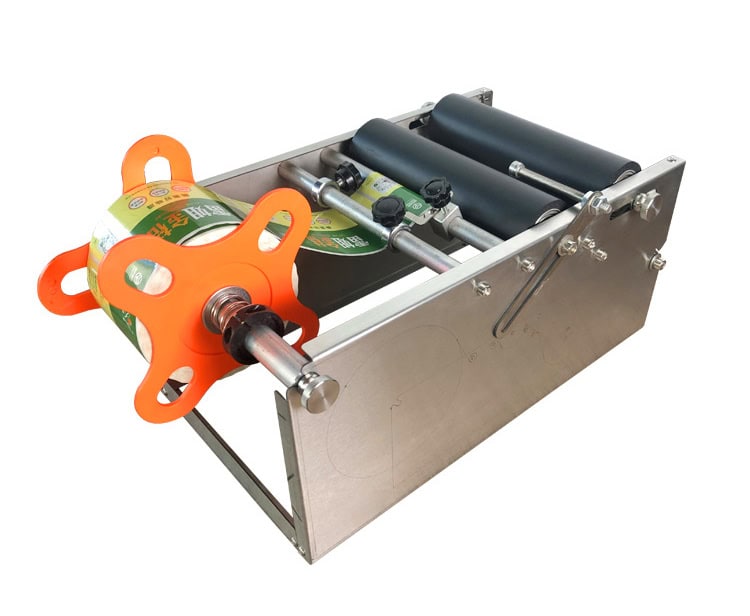
Semi-Automatic Labeling Machines
Semi-automatic labeling machines require some manual intervention but offer higher efficiency than manual machines. These are suitable for medium-scale production, where consistency and speed are crucial. Operators load the bottles into the machine, which then handles the labeling process. Semi-automatic machines strike a balance between cost and efficiency, making them an excellent choice for growing businesses. They are equipped with features that allow quick adjustments, making them versatile for different types of bottles and labels.

Fully Automatic Labeling Machines
Fully automatic labeling machines are designed for high-volume production lines. They require minimal human intervention and can label thousands of bottles per hour, making them perfect for large-scale operations. These machines are integrated into production lines, ensuring seamless operation from bottle feeding to labeling and output. Fully automatic machines come with advanced features such as touch-screen controls, automated label dispensing, and real-time monitoring, which significantly enhance productivity and reduce downtime.
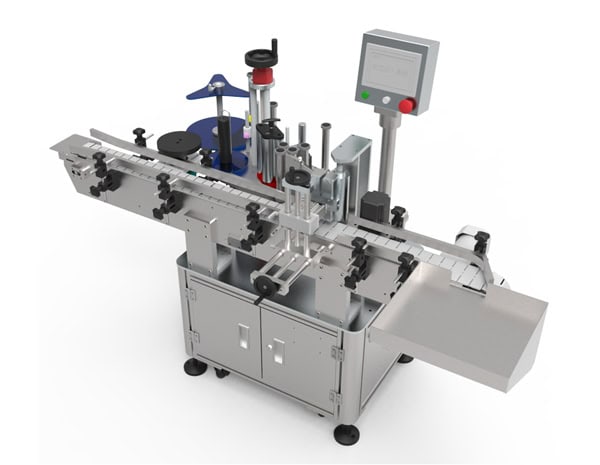
Key Components of Bottle Stickers Labeling Machines
Label Dispenser
The label dispenser holds and feeds the labels into the machine, ensuring that each label is correctly positioned for application. It is a critical component as it determines the accuracy and speed of the labeling process. Modern dispensers are equipped with sensors that detect the presence of a bottle and dispense labels at precise intervals, ensuring consistency. Some dispensers also allow for adjustments in label size and type, providing flexibility for different labeling needs.

Conveyor System
The conveyor system moves the bottles through the machine, aligning them precisely for label application. A well-designed conveyor system ensures smooth and continuous bottle movement, reducing the risk of jams and misalignment. Conveyor systems are adjustable to accommodate bottles of various sizes and shapes, making the machine versatile. Advanced systems also feature speed controls, allowing synchronization with the overall production line speed for optimal efficiency.
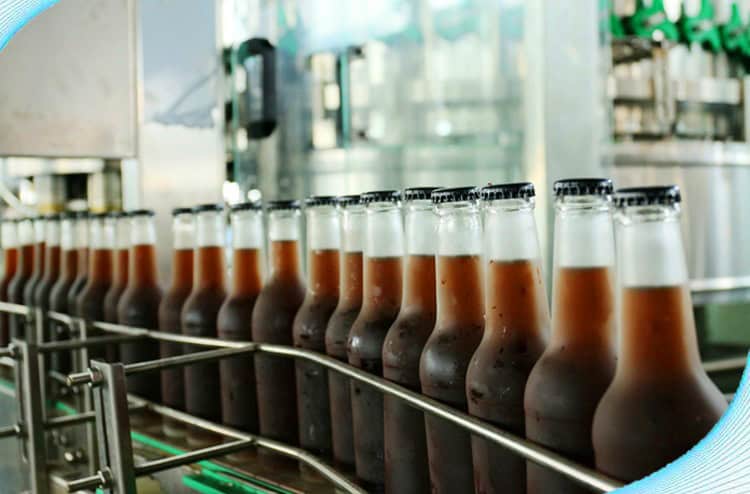
Applicator
The applicator is responsible for placing the label onto the bottle accurately, ensuring no wrinkles or misalignments. This component can vary in design depending on the type of labeling machine. For instance, wrap-around applicators are used for cylindrical bottles, while front and back applicators are used for flat or uniquely shaped bottles. High-quality applicators use precise pressure and positioning to ensure each label adheres smoothly, enhancing the product’s appearance and ensuring the information is legible.
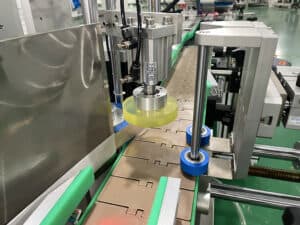
Control Panel
The control panel allows operators to adjust settings, monitor the machine’s performance, and troubleshoot issues as they arise. Modern control panels are user-friendly, often featuring touch-screen interfaces that provide real-time data and diagnostics. Operators can easily adjust the labeling speed, modify label placement, and check for errors. Some advanced control panels also offer remote monitoring capabilities, allowing managers to oversee operations from a different location, thereby increasing efficiency and reducing downtime.
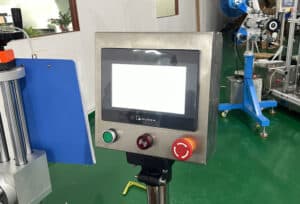
How Bottle Stickers Labeling Machines Work
Feeding Bottles
Bottles are fed into the machine, either manually or through an automated system, and aligned on the conveyor. Proper feeding is crucial to ensure that each bottle is correctly positioned for labeling. Automated systems often include mechanisms that adjust the position of the bottles as they enter the conveyor, ensuring they are perfectly aligned. This reduces the risk of mislabeling and increases the overall efficiency of the labeling process.
Label Dispensing
The label dispenser releases a label for each bottle, positioned precisely for application. The accuracy of this step is critical, as it determines the final placement of the label on the bottle. Advanced dispensers use sensors to detect the exact position of each bottle, ensuring the label is applied at the right moment. This precision minimizes waste and ensures that every bottle is labeled correctly.
Label Application
The applicator applies the label to the bottle, ensuring it adheres smoothly and accurately. This process can vary depending on the type of applicator used. For example, some applicators use rollers to press the label onto the bottle, while others use air pressure. Ensuring smooth application without wrinkles or bubbles is essential for both aesthetic and practical reasons, as a poorly applied label can give a negative impression of the product’s quality.
Quality Control
Quality control systems check for proper label placement and reject bottles that do not meet the standards. These systems often use cameras and sensors to inspect each bottle as it exits the labeling machine. Any bottle that does not meet the set criteria is automatically rejected, ensuring that only properly labeled products proceed to the next stage of production. Implementing rigorous quality control measures helps maintain brand consistency and compliance with regulatory requirements.
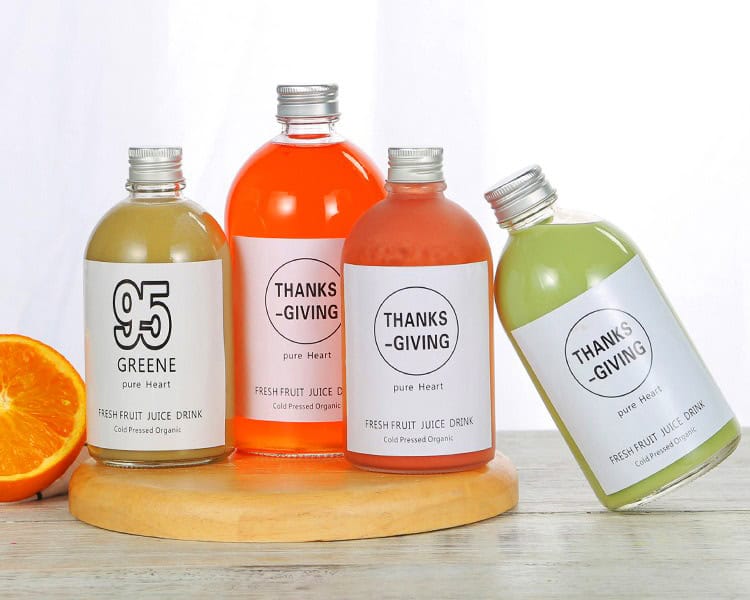
Advantages of Using Bottle Stickers Labeling Machines
Efficiency and Speed
Labeling machines significantly increase the speed of production, allowing businesses to meet high demand without sacrificing quality. Automated systems can label hundreds or even thousands of bottles per hour, a rate that manual labeling cannot match. This increased speed helps businesses scale up their operations and meet market demands promptly.
Consistent Labeling
These machines ensure that every bottle is labeled consistently, which is crucial for brand image and regulatory compliance. Consistent labeling enhances the product’s shelf appeal and ensures that all necessary information is legible and correctly placed. This uniformity is vital for building brand trust and ensuring that consumers can easily recognize and trust your products.
Cost-Effective
Investing in a labeling machine can reduce labor costs and minimize waste due to incorrect labeling. While the initial investment may be significant, the long-term savings in labor and increased production efficiency often justify the cost. Additionally, automated machines reduce the likelihood of errors, further saving costs associated with rework and wasted materials.
Enhanced Production
With automated systems, businesses can scale up their operations and maintain high standards of product labeling. Enhanced production capabilities allow companies to take on larger orders and expand their market reach. Automated labeling also reduces the likelihood of bottlenecks in the production process, ensuring smooth and continuous operation.
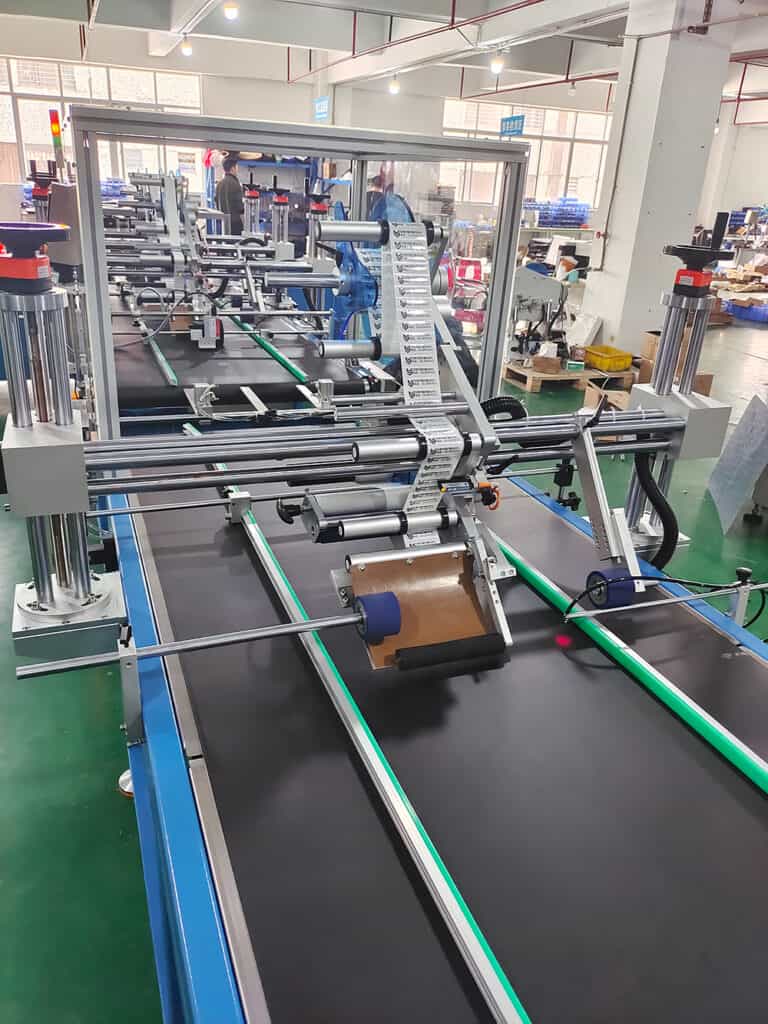
Factors to Consider When Choosing a Bottle Stickers Labeling Machine
Bottle Type and Size
Consider the variety of bottles you need to label. Machines should be compatible with different shapes and sizes to ensure versatility. It is essential to choose a machine that can handle your current production requirements and any future needs as your product line expands. Some machines come with adjustable components that allow them to accommodate different bottle sizes and shapes, providing greater flexibility.
Production Speed
Assess your production needs to choose a machine that can handle your desired output efficiently. Production speed is a critical factor, especially for businesses with high-volume needs. Ensure that the machine you choose can keep up with your production demands without compromising on label quality. It is also beneficial to select a machine with adjustable speed settings to match varying production rates.
Label Type
Ensure the machine can handle the types of labels you use, whether they are paper, plastic, or other materials. Different labels require different handling techniques; for instance, plastic labels might need a different adhesive application method compared to paper labels. Check with the manufacturer to ensure that the machine can accommodate the specific label materials and sizes you plan to use.

Budget and Cost
Evaluate your budget and consider both the initial investment and ongoing maintenance costs of the machine. While it might be tempting to opt for a cheaper model, it is essential to consider the long-term benefits of investing in a higher-quality machine that offers better performance and durability. Also, factor in the cost of any necessary accessories or upgrades and the potential return on investment through increased efficiency and reduced labor costs.
Maintenance and Care for Bottle Stickers Labeling Machines
Regular Cleaning
Keeping the machine clean prevents label adhesive buildup and ensures smooth operation. Regular cleaning involves wiping down surfaces, removing dust and debris, and cleaning adhesive residues from the applicator and conveyor system. Using appropriate cleaning agents recommended by the manufacturer can prevent damage to the machine’s components and prolong its lifespan.
Routine Inspections
Regular inspections help identify and address potential issues before they cause significant problems. Inspections should include checking the alignment of the label dispenser, the condition of the conveyor belt, and the functioning of the applicator. Regularly inspecting the electrical components and connections can also prevent unexpected breakdowns.
Replacing Worn Parts
Timely replacement of worn parts can prevent breakdowns and extend the machine’s lifespan. Components such as rollers, belts, and sensors can wear out over time and affect the machine’s performance. Keeping a stock of essential spare parts and replacing them as needed can minimize downtime and ensure continuous operation.
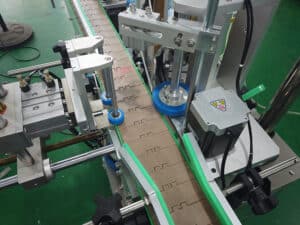
Professional Servicing
Periodic professional servicing ensures the machine operates at peak efficiency and minimizes downtime. Professional technicians can perform detailed inspections, calibrate the machine, and address any complex issues that routine maintenance might not cover. Scheduled servicing by qualified professionals can also help maintain the warranty and extend the machine’s operational life.
Common Issues and Troubleshooting Tips
Label Misalignment
Check the label dispenser and applicator settings to ensure labels are applied straight. Misalignment can occur due to improper settings or worn-out components. Adjusting the position of the label dispenser and ensuring that the bottles are correctly aligned on the conveyor can often resolve this issue. Regularly calibrating the machine and performing test runs can help maintain proper alignment.
Machine Jams
Regular cleaning and proper setup can prevent jams, which are often caused by label or bottle misalignment. Jams can disrupt production and cause damage to the machine. Ensure that labels are correctly loaded and that the conveyor system is free from obstructions. Regularly inspecting and cleaning the machine can prevent common causes of jams.
Uneven Labeling
Adjust the conveyor and applicator settings to ensure even pressure and proper label application. Uneven labeling can result from inconsistent pressure or speed settings. Calibrating the machine and ensuring that all components are in good condition can help achieve even labeling. It is also essential to use the correct type of labels and adhesives to ensure proper adhesion.
Electrical Problems
Regular maintenance and prompt attention to any electrical issues can prevent machine downtime. Electrical problems can range from simple issues like loose connections to more complex ones like faulty sensors. Regularly inspecting the electrical components and ensuring that the machine is grounded correctly can prevent many common electrical issues. If problems persist, consulting a professional technician is advisable.
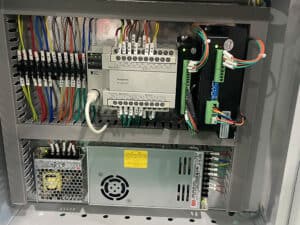
Innovations in Bottle Stickers Labeling Machines
Smart Technology Integration
Modern labeling machines incorporate smart technology for improved precision and efficiency. Features like automated adjustments, real-time diagnostics, and predictive maintenance can significantly enhance productivity. Smart technology allows for better integration with other production line components, enabling seamless operation and reducing the need for manual intervention.
Eco-Friendly Labels
Machines now support the use of eco-friendly labels, helping businesses reduce their environmental footprint. Eco-friendly labels are made from sustainable materials and use environmentally friendly adhesives.
FAQ
Are there machines for both small and large-scale operations?
Yes, there are machines tailored for small-scale, medium-scale, and large-scale operations, depending on production needs. Manual machines are ideal for small-scale or artisanal production, semi-automatic machines for mid-range operations, and fully automatic machines for high-volume production lines. Each type offers different features and capabilities to match the scale of the operation.
What is the average cost of a labeling machine?
The cost varies widely based on the type and features of the machine, ranging from a few thousand to several hundred thousand dollars. Manual machines are typically the least expensive, while fully automatic machines with advanced features can be a significant investment. It is important to consider not only the initial purchase price but also the long-term benefits such as increased efficiency, reduced labor costs, and improved production capacity.
How often should I service my labeling machine?
Regular servicing is recommended every six months to ensure optimal performance and longevity. Routine maintenance checks should include cleaning, inspecting moving parts, and calibrating the machine. More frequent servicing may be necessary for high-use machines to prevent wear and tear and ensure consistent operation.
Conclusion
Bottle stickers labeling machines are vital for efficient and accurate labeling in various industries. Understanding the types, components, benefits, and maintenance of these machines can help businesses choose the right equipment to streamline their production processes. From small-scale manual machines to fully automatic systems designed for high-volume production, there is a labeling solution for every need. Investing in the right machine can enhance productivity, ensure consistent labeling, and reduce operational costs, ultimately contributing to the success and growth of a business.
You may be interested:
- How to Find and Replace Essential Labeling Machine Parts
- Top 10 Strip Packaging Machine Manufacturers in China
- How Tape Wrapping Machines Enhance Efficiency in Industrial Packaging
- Why Choose Our Labeling Machine for Top, Bottom, and Side Labeling of Small Round Boxes?






